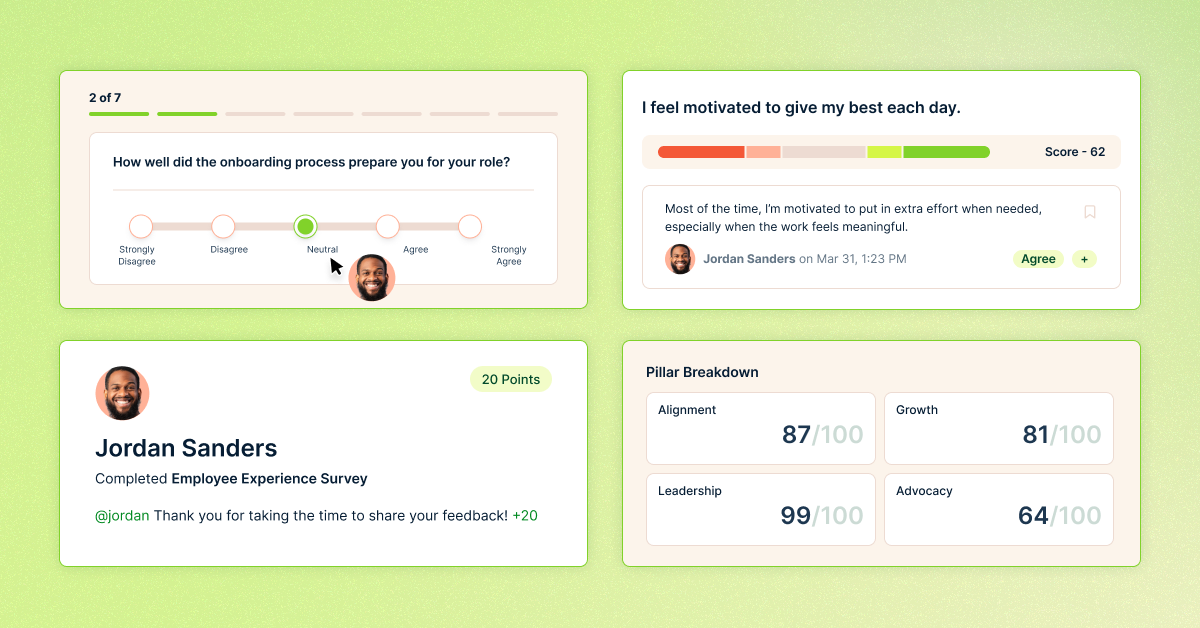Leadership
.svg)
Leadership
What is Leadership?
Leadership in the context of company culture refers to the ability of individuals, particularly those in managerial or supervisory roles, to guide teams effectively through vision, motivation, and support. It involves not only directing the actions of team members but also fostering an environment where employees feel valued, empowered, and engaged. Leadership is characterized by effective communication, emotional intelligence, and the capacity to inspire others toward achieving shared goals and objectives.
Why is Leadership important?
Leadership is vital for organizations as it directly influences employee engagement, morale, and overall company performance. Effective leaders create a positive workplace environment that promotes collaboration, innovation, and accountability. By establishing a clear vision and aligning team efforts with organizational goals, leaders help ensure that everyone is working towards a common purpose. This alignment enhances productivity and can lead to higher employee retention rates, as team members are more likely to remain with a company that demonstrates strong leadership. Furthermore, effective leadership fosters a culture of trust and respect, which is essential for psychological safety and encourages employees to voice their ideas and concerns openly.
How to implement Leadership?
To integrate effective leadership within an organization’s culture, consider the following actionable steps:
- Develop Leadership Training Programs: Invest in training sessions that focus on leadership skills such as communication, conflict resolution, emotional intelligence, and decision-making.
- Model Leadership Behaviors: Encourage existing leaders to model the behaviors and values expected from their teams. This includes demonstrating accountability, transparency, and integrity.
- Encourage Open Communication: Create channels for open dialogue between leadership and employees. Regular check-ins, feedback sessions, and town hall meetings can facilitate this.
- Empower Employees: Foster a culture where employees feel empowered to take initiative and make decisions. This can be achieved by delegating responsibilities and recognizing individual contributions.
- Establish Mentorship Programs: Pairing less experienced employees with seasoned leaders can provide guidance, support, and a clearer pathway for career development.
Benefits of Leadership
Organizations that successfully embrace effective leadership can expect several tangible benefits, including:
- Enhanced Employee Engagement: Employees are more likely to be engaged and motivated when they feel supported by their leaders.
- Increased Productivity: Clear direction and inspired employees lead to improved performance and higher output.
- Lower Turnover Rates: Strong leadership fosters a positive work environment, making employees less likely to leave the organization.
- Better Decision Making: Leaders who encourage diverse perspectives can make more informed and effective decisions.
- Stronger Organizational Culture: Leadership shapes the company’s values and behaviors, creating a cohesive culture that aligns with its mission and vision.
Common challenges with Leadership
Organizations may encounter several challenges when trying to implement effective leadership, including:
- Resistance to Change: Employees may be skeptical about new leadership initiatives. Overcome this by involving them in the process and addressing their concerns.
- Lack of Skill Development: Not all leaders possess innate leadership skills. Providing comprehensive training and support can help bridge this gap.
- Inconsistent Leadership Styles: Different leaders may have varying approaches, leading to confusion and mixed messages. Establishing a clear leadership framework can help standardize expectations.
- Ineffective Communication: Poor communication can create barriers between leaders and employees. Encourage regular feedback and open dialogue to improve this aspect.
By recognizing and addressing these challenges, organizations can work towards cultivating a culture of effective leadership that enhances overall performance and employee satisfaction.





